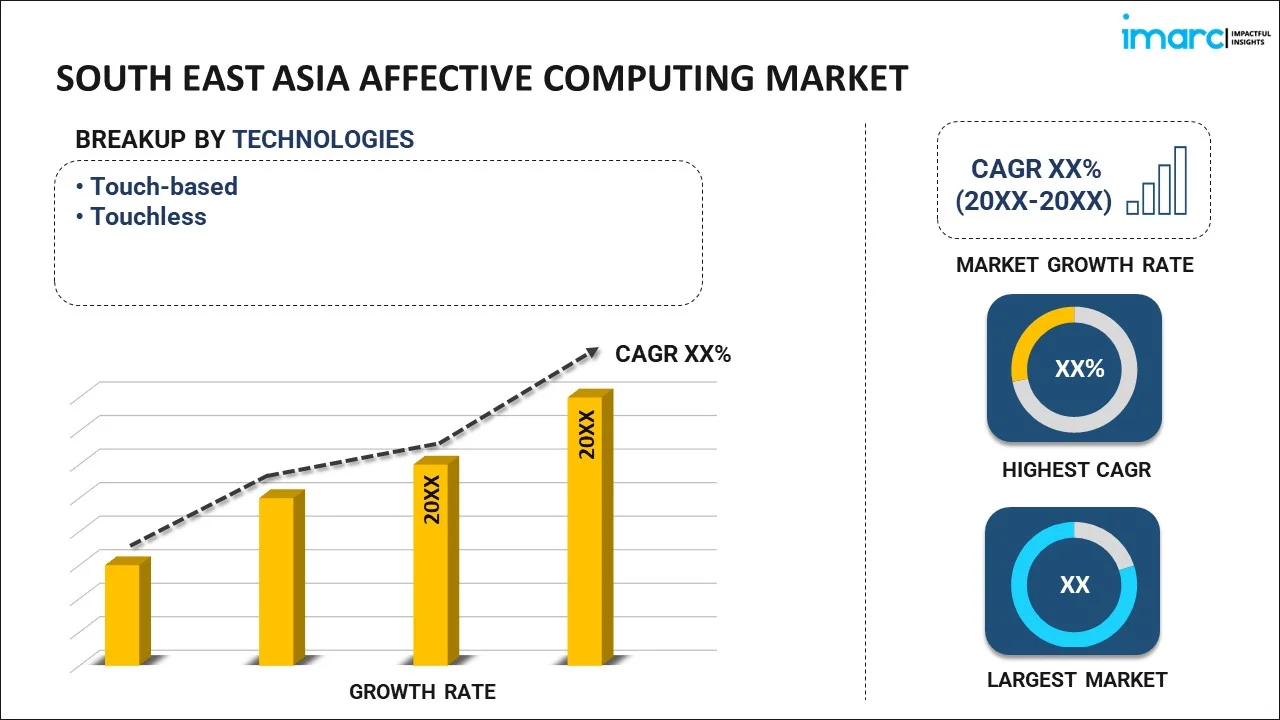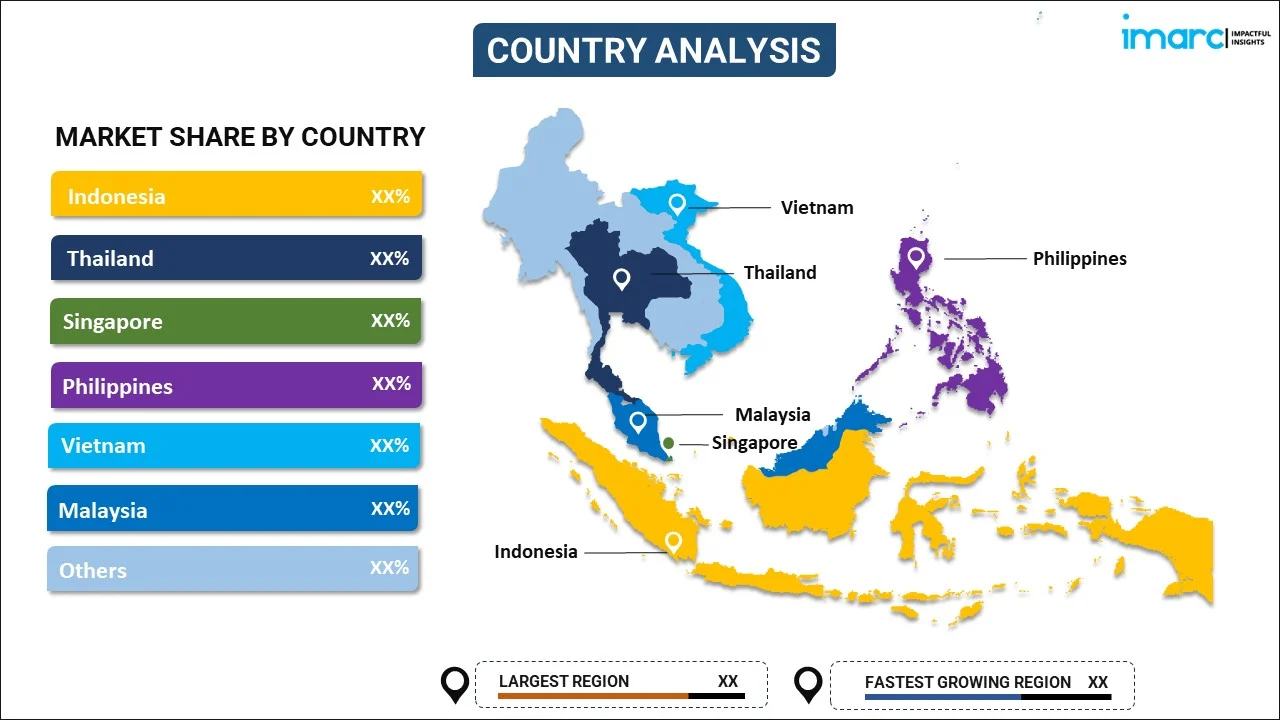
South East Asia Affective Computing Market Report by Technology (Touch-based, Touchless), Component (Hardware, Software), End Use (Automotive, BFSI, Government, Healthcare, IT and Telecom, and Others), and Country 2025-2033
Market Overview:
South East Asia affective computing market size is projected to exhibit a growth rate (CAGR) of 3.17% during 2025-2033. The increasing demand for emotionally intelligent human-computer interaction, the growth of the digital economy, emphasis on customer experience, expanding healthcare and education applications, proliferation of wearable technology, supportive government initiatives, and mental health awareness represent some of the key factors driving the market.
|
Report Attribute
|
Key Statistics
|
|---|---|
|
Base Year
|
2024 |
|
Forecast Years
|
2025-2033
|
|
Historical Years
|
2019-2024
|
| Market Growth Rate (2025-2033) | 3.17% |
Affective computing is a multidisciplinary field of computer science and psychology that focuses on developing systems and technologies capable of recognizing, interpreting, and responding to human emotions. The goal of affective computing is to enable machines to understand and appropriately react to human emotions, creating more empathetic and human-like interactions between humans and computers. This involves the integration of various technologies, such as facial recognition, speech analysis, biometric sensors, and natural language processing to detect and interpret emotional cues. Affective computing systems aim to discern basic emotions like happiness, sadness, or anger as well as more nuanced aspects of human expression, such as sarcasm or empathy. Affective computing finds numerous applications ranging across human-computer interaction, virtual reality (VR), healthcare, education, and customer service. By incorporating emotional intelligence into machines, affective computing seeks to enhance user experience, improve personalization in technology-driven interactions, and contribute to the development of emotionally aware and responsive artificial intelligence systems.
South East Asia Affective Computing Market Trends:
The increasing integration of affective computing in human-computer interaction, as businesses and consumers alike seek more personalized and emotionally intelligent technology interfaces, represents the key factor driving the market growth. Besides this, the region's thriving digital economy, marked by a significant increase in online activities, is fueling the need for advanced technologies, such as affective computing, that are capable of understanding and responding to user emotions. Moreover, the rising focus on customer experience in the business landscape is driving the adoption of affective computing in e-commerce, social media, and online entertainment platforms, enhancing user experiences and engagement, thereby strengthening the market growth. In confluence with this, the increasing adoption of affective computing across the thriving healthcare sector for emotion recognition in patient care, mental health diagnostics, and therapeutic applications is acting as another significant growth-inducing factor. Concurrently, the education sector is also witnessing increased utilization of affective computing technologies to enhance personalized learning experiences, adapt content based on student emotions, and provide valuable insights for educators, which is further aiding in market expansion. In addition to this, the proliferation of wearable devices and Internet of Things (IoT) technologies that are integrated with affective computing to monitor and analyze user emotions in real time is providing an impetus to the market growth. Furthermore, the growing emphasis on mental health awareness and wellness in South East Asia fostering the demand for affective computing solutions designed to support mental well-being through emotion tracking and analysis is creating a positive outlook for market expansion. Apart from this, extensive government initiatives and investments in artificial intelligence (AI) and technology innovation are contributing significantly to the expansion of the affective computing market.
South East Asia Affective Computing Market Segmentation:
IMARC Group provides an analysis of the key trends in each segment of the market, along with forecasts at the regional and country levels for 2025-2033. Our report has categorized the market based on technology, component, and end use.
Technology Insights:

- Touch-based
- Touchless
The report has provided a detailed breakup and analysis of the market based on the technology. This includes touch-based and touchless.
Component Insights:
- Hardware
- Sensors
- Cameras
- Storage Devices and Processors
- Others
- Software
- Analytics Software
- Enterprise Software
- Facial Recognition
- Gesture Recognition
- Speech Recognition
A detailed breakup and analysis of the market based on the component have also been provided in the report. This includes hardware (sensors, cameras, storage devices and processors, and others) and software (analytics software, enterprise software, facial recognition, gesture recognition, and speech recognition).
End Use Insights:
- Automotive
- BFSI
- Government
- Healthcare
- IT and Telecom
- Others
The report has provided a detailed breakup and analysis of the market based on the end use. This includes automotive, BFSI, government, healthcare, IT and telecom, and others.
Country Insights:

- Indonesia
- Thailand
- Singapore
- Philippines
- Vietnam
- Malaysia
- Others
The report has also provided a comprehensive analysis of all the major regional markets, which include Indonesia, Thailand, Singapore, Philippines, Vietnam, Malaysia, and Others.
Competitive Landscape:
The market research report has also provided a comprehensive analysis of the competitive landscape. Competitive analysis such as market structure, key player positioning, top winning strategies, competitive dashboard, and company evaluation quadrant has been covered in the report. Also, detailed profiles of all major companies have been provided.
South East Asia Affective Computing Market Report Coverage:
| Report Features | Details |
|---|---|
| Base Year of the Analysis | 2024 |
| Historical Period | 2019-2024 |
| Forecast Period | 2025-2033 |
| Units | Million USD |
| Scope of the Report | Exploration of Historical and Forecast Trends, Industry Catalysts and Challenges, Segment-Wise Historical and Predictive Market Assessment:
|
| Technologies Covered | Touch-based, Touchless |
| Components Covered |
|
| End Uses Covered | Automotive, BFSI, Government, Healthcare, IT and Telecom, Others |
| Countries Covered | Indonesia, Thailand, Singapore, Philippines, Vietnam, Malaysia, Others |
| Customization Scope | 10% Free Customization |
| Post-Sale Analyst Support | 10-12 Weeks |
| Delivery Format | PDF and Excel through Email (We can also provide the editable version of the report in PPT/Word format on special request) |
Key Questions Answered in This Report:
- How has the South East Asia affective computing market performed so far and how will it perform in the coming years?
- What has been the impact of COVID-19 on the South East Asia affective computing market?
- What is the breakup of the South East Asia affective computing market on the basis of technology?
- What is the breakup of the South East Asia affective computing market on the basis of component?
- What is the breakup of the South East Asia affective computing market on the basis of end use?
- What are the various stages in the value chain of the South East Asia affective computing market?
- What are the key driving factors and challenges in the South East Asia affective computing?
- What is the structure of the South East Asia affective computing market and who are the key players?
- What is the degree of competition in the South East Asia affective computing market?
Key Benefits for Stakeholders:
- IMARC’s industry report offers a comprehensive quantitative analysis of various market segments, historical and current market trends, market forecasts, and dynamics of the South East Asia affective computing market from 2019-2033.
- The research report provides the latest information on the market drivers, challenges, and opportunities in the South East Asia affective computing market.
- Porter's five forces analysis assist stakeholders in assessing the impact of new entrants, competitive rivalry, supplier power, buyer power, and the threat of substitution. It helps stakeholders to analyze the level of competition within the South East Asia affective computing industry and its attractiveness.
- Competitive landscape allows stakeholders to understand their competitive environment and provides an insight into the current positions of key players in the market.
Need more help?
- Speak to our experienced analysts for insights on the current market scenarios.
- Include additional segments and countries to customize the report as per your requirement.
- Gain an unparalleled competitive advantage in your domain by understanding how to utilize the report and positively impacting your operations and revenue.
- For further assistance, please connect with our analysts.
 Inquire Before Buying
Inquire Before Buying
 Speak to an Analyst
Speak to an Analyst
 Request Brochure
Request Brochure
 Request Customization
Request Customization




.webp)




.webp)












